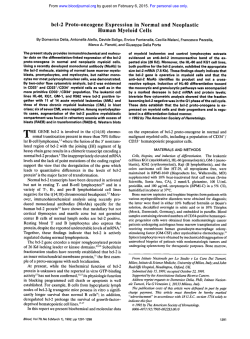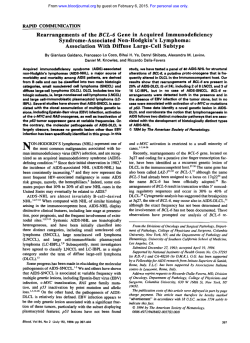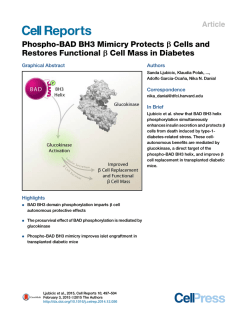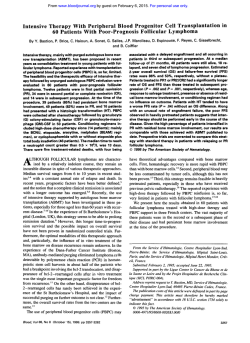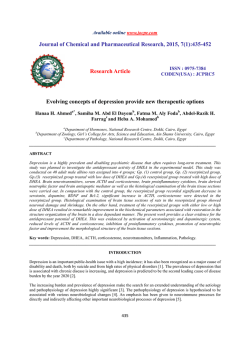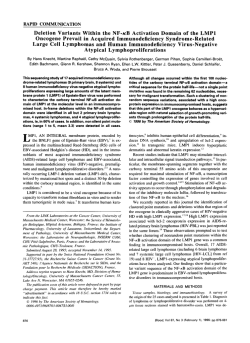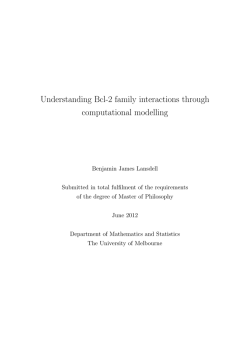
Prognostic Significance of bcl-2 Protein Expression in
From www.bloodjournal.org by guest on February 6, 2015. For personal use only. Prognostic Significance of bcl-2 Protein Expression in Aggressive Non-Hodgkin’s Lymphoma By Olivier Hermine, Corinne Haioun, Eric Lepage, Marie-FranCoise d‘Agay, Josette Briere, Caroline Lavignac, Georges Fillet, Gilles Salles, Jean-Pierre Marolleau, Jacques Diebold, Felix Reyes, Philippe Gaulard, for the Groupe d‘Etude des Lymphomes de I’Adulte (GELA) L i i l e is knownabout the expression of bcl-2 protein in intermediate and high grade non-Hodgkin‘slymphoma (NHL) and its clinical and prognostic significance. We performed immunohistochemical analysis of bcl-2 expression in tumoral tissue sections of 348 patients with high or intermediate grade NHL. These patients were uniformly treated with adriamycin, cyclophosphamide, vindesine, bleomycin, and prednisone (ACVBP) in the induction phase ofthe LNH87 protocol. Fifty eight cases were excluded duet o inadequate staining. Of the 290 remaining patients, 131 (45%)disclosed homogeneous positivity (high bcl-2 expression)in virtually all tumor cells, whereas 65 (23%) were negative and 94 (32%) exhibited intermediate staining. High bcl-2 expression was more frequent in B-cell NHL (109of 214,5196) than in T-cell NHL (6 of 35,17%) (P= .0004), and was heterogeneouslydistributed among the different histological subtypes. Further analysis was performed on the 151 patients with diffuse large B-cell lymphoma (centroblastic and immunoblastic) t o assess the clinical significance and potential prognostic value of bcl-2 expressionin the most frequent and homogeneous immunohistological subgroup. High bcl-2 expression, found in 44% of thesepatients (67 of 151 1, was more frequently associated with Ill-IV stage disease ( P = .002).Reduceddisease-free survival (DFS) ( P < .01) and overall survival (P< .05) were demonstrated in the patients with high bel-2 expression. Indeed, the 3-year estimatesof DFS and overall survival were 60% and 61%. respectively (high bcl-2 expression) versus 82% and 78%, respectively (negativelintermediate bcl-2 expression). A multivariate regression analysis confirmed the independent effect of bcl-2 protein expression on DFS. Thus bcl-2 protein expression, as demonstrated in routinely paraffin-embeddedtissue, appears t o be predictive of poor DFS, in agreementwith the role of bcl-2 in chemotherapy-induced apoptosis. It might be considered as a new independent biologic prognostic parameter, which, especially in diffuse large B-cell NHL, could aid in the identification of patient risk groups. 0 1996 by The American Societyof Hematology. T genesis and in the development of drug resistance, in follicular, as well as in other varieties of lymphomas. This would provide support for the potential clinical value of bcl-2 protein expression in NHLs, as recently suggested in acute myeloid leukemias“ and lung carcinoma.” However, only few studies have focused on the correlation between bcl-2 expression at the protein level and clinical presentation and outcome in folliculd5 or d i f f ~ s e lymphomas. ~~.~~ This prompted us to analyze the distribution of bcl-2 at the protein level according to histology and phenotype in 290 uniformly treated patients with intermediate or high-grade NHLs enrolled in the LNH87 protocol.2’ To assess its clinical significance and its potential prognostic value, we focused on the correlation between bcl-2 expression, clinical features, and outcome in diffuse large B-cell lymphomas, which is the most frequent and homogeneous immunohistological subgroup of the present series. HE BCL-2 gene was initially discovered by virtue of its involvement in the t(14; 18) (q32;q21) tran~location.l-~ This chromosomal abnormality, resulting in production of high levels of bcl-2 protein, is observed in the majority of follicular non-Hodgkin’s lymphomas (NHLs) and in about 20%of diffuse large B-cell lymphoma^."^ However, the expression of bcl-2 protein is not restricted to B-cell lymphomas bearing the t( 14; 18) translocation.’ Indeed, immunohistochemical studies have shown that, beside follicular lymphoma^,^,' a broad spectrum of lymphoid malignancies including chronic lymphocytic leukemia, plasma cell dyscrasia, diffuse large B- and T-cell lymphomas,” as well as non-lymphoid tumors of lung,” breast,” prostate13 or liver origin,I4 also express the bcl-2 protein. Finally, the bcl-2 protein is also detected in a number of normal tissues, including B lymphocytes of the mantle zone and normal T cell^.'^'^ Bcl-2 can be regarded as a member of a new category of oncogenes that is involved in cell survival, by blocking programmed cell death, also called apoptosis. Deregulated bcl-2 extends the survival of some interleukin-dependent hematopoietic cell lines when deprived of growth factors.” In vivo, bcl-2-Ig transgenic mice express constitutively a high level of bcl-2 protein, and thus accumulate an excess of resting IgIWIgD B cells because of extended survival.’’ Thus, constitutive bcl-2 expression might cooperate with the activation of other oncogenes, such as c-myc, in a multistep development of lymphomas.” It has been shown that apoptosis occurs in a majority of lymphoid cells when treated by various antineoplastic agents commonly used in the treatment of NHLs.~’.~’Recent in vitro studies on murine and human leukemia cell lines have demonstrated that, although not preventing suppression of cell proliferation, high levels of bcl-2 protein could protect the cells from undergoing apoptosis in the presence of glucocorticoids and multiple chemotherapic Taken together, these findings suggest that a high level of bcl-2 protein may play an important role both in lymphomaBlood, Vol 87, No 1 (January l ) , 1996:pp 265-272 From the Dkpartements de Pathologie, Hepita1 Henri Mondor, Criteil; H6pital Saint-Louis, H6pital Laennec, H6pital H6tel Dieu, Paris; H6pital Dupuytren, Limoges; the Services d’Himatologie clinique, H6pital Necker, Paris; H6pital Henri Mondor,Crkteil; Universite‘de LiZge, Li2ge, Belgium; Centre Hospitalier Lyon-Sud, Pierre Benite; Hapita1 Saint-Louis, Paris; and the Dkpartement de Biostatistique et Informatique Medicale, H6pital Saint-Louis, Paris, France. Submitted February 9, 1995; accepted August 15, 1995. Supported in part by grants from C.N.A.M.T.S. and ER 270from Universite‘ Paris-Valde-Marne. Address reprint requests to Philippe Gaulard, MD, Dkpartement de Pathologie, Hapita1 Henri Mondor, Creteil ce‘dex, France. The publication costsof this article were defrayedin part by page charge payment. This article must therefore behereby marked “advertisement” in accordance with 18 U.S.C. section 1734 solely to indicate this fact. 0 1996 by The American Society of Hematology. OOO6-4971/96/8701-0020$3.00/0 265 From www.bloodjournal.org by guest on February 6, 2015. For personal use only. 266 HERMINE ET AL responder patients were treated with the LNH 84 sequential chemoMATERIALS ANDMETHODS the rap^.'^ No difference in disease-free survival (DFS) and survival Patients studied for the expression of bcl-2 at the protein level betweenthesetwoconsolidativeprocedures has been demonare a subset of the 2,947 patients entered on the LNH87 protocol, strated.’x prospective a multicentric trial of the Groupe d’Etude des Bcl-2 stuining. Staining for bcl-2 was performed, as previously LymphomesdeI’Adulte(GELA),betweenOctober I , 1987and described’ on deparaffinized sections by the alkaline-phosphatase/ April 1, 1992.28”” anti-alkaline-phosphatase (APAAP) procedure (Dako SA, Glostrup. LNH87prorocol design. Previously untreated adult patients with Denmark),using a monoclonalantibodyspecificfor bcl-2 (bc12/ intermediate or high-grade NHL according to the Working Formula124) (Dako SA). Optimum labeling was obtainedby twice repeating tion(WF)”were stratified intothreegroupsonthebasis of age the bridge and APAAP complex. All immunohistochemical analyses and prognostic factors and were then randomized to receive either were performed in a single laboratory. One slide of each case was ACVBP (adriamycin, cyclophosphamide, vindesine, bleomycin and evaluated for bcl-2 staining by two investigators (O.H., P.C.). The prednisone),whichwasthereferenceinductiontreatment arm or 58 excluded patients were cases in which bcl-2 staining failed to another alternating anthracyclin-containing regimen. Eligibility crishow any positive reaction onboth neoplastic cells and normalsmall teria was as follows: patients under 70, with biopsy proven intermelymphocytes that normally act as positive internal controls. Among diate or high-grade histologies (WF, categories D through J). Excluthe290remainingcases,threepatternsofreactivityweredistinsioncriteriaincludedpriortreatment,apositiveserologytothe guishedaccording to the estimatedpercentage of malignantcells human immunodeficiency virus, concomitantor previous cancer (exstained for bcl-2 (Fig 1). Cases with the most tumor cells positive cept in situ cervix carcinoma or skin epithelioma), heart disease. (more than 60%) were considered as lymphomas with “high bcl-2 uncontrolled diabetes mellitus, liver or kidney failure. Patients with expression”: in thesecases,tumoralcellswere usually strongly a previous historyof low-grade NHL or with bone marrowor central labeled. Cases with heterogeneous labeling, ie, bcl-2 positive neonervous system involvement in the settingof Burkitt or lymphoblasplastic cells admixed in the same area with bcl-2 negativeneoplastic tic histology were also excluded. A centralized histological review cells, were categorized as lymphomas with “intermediate bcl-2 exand phenotypic study was strongly encouraged in the LNH87 protopression”. Cases with virtually all tumor cells negative(>95%), but coldesign.Thus,unstainedslides of theinitialbiopsyspecimen with small reactive lymphocytes positive, were classified as “bclwere available in 85% of cases. The histopathologic diagnoses were 2-negative’’lymphomas.Fortheanalysis,areas of highest bcl-2 based on consensus review by three hematopathologists, and expression evident at lower power scanning were considered. The lymphomas were classified according to the W F and the Kiel classistainingwasconsideredasnegativeorintermediateaftercareful fication.’* The Ki-l(CD30)positiveanaplasticlargecellsubtype examination of the entire tissue section at high power scanning. was added to the categories of the WF. Immunophenotypic studies Stutisticul unalysis. Patients’characteristicswerecompared uswere performed on deparaffinized tissue sections using a panel of ing chi-square tests. The stopping date wasfixed on March 3 I , I994 monoclonal antibodies directed against B (CD20/L26,CDw75LN I , providing a median follow-up of 44 months. The period of survival MB2), and T (CD3, CD45RoKJCHLI)-cell associated antigens to wascalculatedfromthedate of registration in thestudy to the assess the B- or T-cell lineage of the lymphoma. Lymphomas were stopping date or death or date of last follow-up when the stopping considered of B-cell derivation if tumor cells expressed CD20 antidate was not reached. DFS was measured as the interval between genand/orwereMB2andCDw75positive, but did not express the date of complete remission after induction treatment and stopping CD3. They were considered of T-cell derivation if tumor cells exdate, or relapse, death, or date of last follow-up evaluation whenthe pressed CD3 antigen or, if CD3 negative, were CD45Ro positive, stopping date was not reached. The rates of DFS and survival were anddid not expressCD20,CDw75andMB2.Lymphomaswere estimated by the method of Kaplan and Meierqi and were compared considered as having an undetermined phenotype when any other according to the treatment groups by log-rank tests.’’ Relative risks combination was observed. were estimated with the Cox regression model.” All significant tests Patient selecriun. We chose to analyze bcl-2 protein expression were two-sided. Because the pattern “high bcl-2 expression” was among patients uniformly treated by the ACVBP induction regimen. to discriminate,wechose to comparethe unequivocalandeasy subgroup “high bcl-2 expression” with the other two. Among the patients with histologically reviewed NHL whoreceived ACVBP, 348 were selected at random to analyze the distribution of RESULTS bcl-2 expression according to histology and phenotype. Fifty eight caseswereexcludedduetoinadequatetissuefor bcl-2 staining. Irnmunostuining for bcl-2 protein. Of the290 patients Histological and phenotypic characteristics of the 290 patients of studied, 131 (45%) disclosed high bcl-2 protein expression. the bcl-2 protein study group are indicated in Table I . Among these In such cases, most, if not all,tumor cells were found to 290 patients, 151 patients had diffuse large-cell (centroblastic and have bcl-2 protein. In addition, staining was usually strong immunoblastic) lymphoma of B-cell origin, which represented the with neoplastic cells more intensively stained than normal mostimportantandhomogeneousimmunohistologicalsubgroup. small lymphocytes. Among the remaining cases, 65 (23%) These were specially analyzed for clinical and prognostic correlawere considered bcl-2 negative, and 94 (32%) exhibited an tions. Clinical features of these 151 patients and of the remaining 267 eligible patients (ie, with diffuse large B-cell NHL who received intermediate staining with bcl-2 positive and bcl-2 negative ACVBP) of the LNH87 protocol are compared in Table 2. The two neoplasticcells admixed in the same areas. The staining groups did not differ for the distribution of either adverse prognostic patterns are illustrated in Fig 1. factors or histological subgroups. Table 3 provides the distribution Bcl-2 expression and histological and irnmunophenotypic into the risk groups of the International Prognostic Index” for the churucteristics. The expression of bcl-2 according to histo15 1 patients studied for bcl-2, as compared with the corresponding logical subtypes and immunophenotype is shown in Table patients treated identically during the same period. These data indi4.Differenceswere noted accordingto bcl-2expression cate that thepatientbcl-2studygroupwasrepresentativeofthe among the different histological subgroups. All cases of difpatientpopulation with diffuselargeB-cellNHLenteredonthe fuse small cleaved cell lymphoma (ie,mantle-cell NHL) LNH87 protocol. Thirteen patients in complete response were ranexhibited high bcl-2 expression, whereas the latter pattern domized to receive a high-dose chemotherapy regimen followed by ranged from 32% to58% of the other histological subgroups. autologousbonemarrowtransplantation;theremaining 98 good- From www.bloodjournal.org by guest on February 6, 2015. For personal use only. 267 bcl-2 PROTEIN EXPRESSION IN NON-HODGKIN’S LYMPHOMA Table 1. Distribution of the 290 Patients Studied for bcl-2 Expression Accordingto Histology and Phenotype Histology WF Kiel Diffuse small cleaved Diffuse mixedt Follicular large cell Diffuse large cell (including immunob1astic)t Small noncleaved (Burkitt) Lymphoblastic Anaplastic* Unclassifiable Centrocytic,” 13 Centroblastic centrocytic, 5 Polymorphic immunocytoma, 10 Lymphoepithelioid (Lennert‘s), 6 Angioimmunoblastic (AILDktype, 9 Follicular centroblastic, 24 Centroblastic, 142 lmmunoblastic B, 9 Pleomorphic T medium large, 10 Burkitt, 5 Lymphoblastic T, 5 Anaplastic, 22 Unclassifiable, 6 Phenotype§ B cell T cell Abbreviation: WF, Working Formulation. * Mantle-cell lymphomas. t 24 cases (2, diffuse mixed; 22, diffuse large cell) were of undetermined phenotype and were not subcategorized according to Kiel. *The Kil(CD30) anaplastic large cell subtype was added to the categories of the WF. 4 Not available in8 cases; 33 (11%) cases were of “null” phenotype. cells was statistically more frequent in B-cell lymphomas (109 of 214,51%) than in T-cell lymphomas (6 of 35, 17%) (P = .0004). Bcl-2 expression and clinical features. Bcl-2 expression according to the clinical characteristics of the patients was studied in the whole group and in the group of patients having diffuse large B-cell lymphoma. For the group having diffuse large-cell lymphoma of B-cell phenotype, the “high bcl-2 expression” pattern was morefrequent in patients with 111-IV stage disease at presentation (P = .002) (Table 5) whereas, in the whole group, this pattern wasmore frequently associated with nodal presentation ( P = .03), bone marrow involvement (P = .04), and 111-IV stage disease (P = .003). In contrast, there was no association of bcl-2 expression with the other prognostic factors of the International Inde23: lactate deshydrogenase (LDH), number of extranodal sites, and performance status. Bcl-2 expression and outcome in dijiue largeB-cell lymphomas. To evaluate the prognostic significance of bcl2 protein expression, analysis of outcome was restricted to the patients with diffuse large B-cell lymphomas, because the latter represent the most frequent and homogeneous immunohistological subgroup in the present series. This demonstrated on the 151 patients with diffuse large B-cell lymphoma a significant difference in DFS ( P < .01)and survival (P < .05) based on the level of bcl-2 expression (Table 5). Indeed, for patients with high bcl-2 expression, the 3-year estimates of DFS and survival were 60% and 61%, respectively, whereas the 3-year estimates of DFS and survival in the bcl-2 negativeheterogeneous subgroup were 82% and 78% as illustrated in Fig 2A and B. Multivariate analysis showed that only high bcl-2 expression (P = .01) and performance status (P = .04) adversely affected DFS. However, only performance status independently affected overall survival (P = .002). Of the 183 patients with diffuse large cell lymphoma (including immunoblastic lymphoma), 78 (43%) were shown to have high bcl-2 expression. This pattern was also found in 67 (44%) of the 151 patients with diffuse large cell lymphoma of B-cell origin. With respect to phenotype, high bcl-2 expression in tumor In the present report, we have studied the expression of bcl-2 protein in an homogeneously treated group of patients with high-or intermediate-grade of NHL. We show that bcl2 is expressed by lymphoma cells with a high frequency Table 2. Clinical Features of the 151 Patients With Diffuse Large B-Cell LvmDhoma Studied for bcl-2 ExDression Table 3. Distribution of Patients With Diffuse Large B-Cell Lymphoma in Risk Groups Using the International Prognostic Index Clinical Features bcl-2 Study Group (n = 151) Remaining Eligible Patients (n = 267) No. (%l No. ( 4 6 ) Age ( > 6 0 yr) (26) 68 47 (31) (male) Sex 86 (57) (Ill-IV) Stage 88 (58) Performance Status (22) 30 (20) LDH ( > l N) (58) 84 Extranodal sites (>l) 28 (19) 3-yr DFS (%) 72 f 8 3-yr survival ( 9 6 ) 70 f 8 bcl-2 Study Group (n = 151) Remaining Patientst Significant Difference P = .2 148 (55) 146 (56) (25) 66 147 (58) 38 (14) 68 2 7 65 2 6 DISCUSSION P = .7 P = .7 5P = .3 P = .9 P = .2 P = .3 P = .3 These 151 patients are compared with the other eligible patients (with diffuse large B-cell NHL) entered on the LNH87 protocol in the same period. Score’ 0-1 2 3 4-5 bcl-2 Positive bcl-2 Negative/ Heterogeneous 45 20 13 18 23 20 7 (8) 1%) (42) (28) (22) In = 267) (%) 127 (48) 70 (28) 40 (15) 30 ( 1 1 ) BCL-2 study group is compared with other eligible patients entered on the LNH87 protocol in the same period. * Score defined according to the international index: low,score 01; low-intermediate, 2; high-intermediate, 3; high, 4-5. t There is no significant difference in risk group distribution between patients studied for BCL-2 expression and the other eligible patients (P= .2). From www.bloodjournal.org by guest on February 6, 2015. For personal use only. 268 HERMINE ET AL 1 Fig 1. Bcl-2 staining. (A) Case with high bcl-2 expressionshowing strong labelling of virtually all tumor cells; (B) casewith heterogeneous bcl-2 expression. In the same area, sometumor cells are positive, whereasothers are negative;(C) Bcl-2 negativecase. Tumor cellsdo not exhibit bcl-2 expression, whereassmall reactive lymphocytes that act as internal positive controls are bcld positive. Paraffin sections,APAAP technique. regardless of histologic subgroups, and that high bcl-2 expression is correlated with B-cell phenotype. Furthermore, clinical correlations performed in the morehomogeneous immunohistological group of diffuse large B-cell NHL disclose that high bcl-2 expression is correlated with extended stage ofthe disease and appears to beassociatedwitha poor prognosis. Indeed, DFS and survival were significantly reduced in patients with high bcl-2 expression, although the independent effect of high bcl-2 expression, at the time of analysis, could be demonstrated only on DFS. To date, most studies of the bcl-2 gene have focused on the presence of the t(14; IS), which have been found in the From www.bloodjournal.org by guest on February 6, 2015. For personal use only. 269 bcl-2 PROTEIN EXPRESSION IN NON-HODGKIN'S LYMPHOMA Table 4. Histologicaland ImmunohistologicalCharacteristics of the 290 Patients Studied for bcl-2 Protein Expression Accordingto the Pattern of bcl-2 Staining bcl-2 Negative/ Heterogeneous bcl-2 Positive No. 1961 No. (%l Histology (WF, Kiel) No Diffuse small cleaved, 13 centrocytic," 13 Diffuse mixed,t 32 Centroblastic centrocytic, 5 Polymorphic immunocytoma, 10 Lymphoepithelioid (Lennert's), 6 Angioimmunoblastic (AILD)-type, 9 Follicular large cell, 24 follicular centroblastic, 24 Diffuse large cell (includes immunoblastic),t 183 Centroblastic, 142 lmmunoblastic B, 9 Pleomorphic T medium and large, 10 Small non-cleaved (Burkitt), 5 Burkitt, 5 Lymphoblastic, 5 Lymphoblastic (T), 5 Anaplastic,* 22 Anaplastic B, 9 Anaplastic T+nul, 13 Unclassifiable, 6 Total 290 Phenotype§ B (n = 214) T (n = 35) ~~ ~ * Mantle-cell lymphomas. t 24 cases (2, diffuse mixed; 22, diffuse large cell) were of undetermined phenotype and were not subcategorized according to Kiel. *The Kil(CD30) anaplastic large cell subtype was added to the categories of the WF. § Not available in 8 cases; 33 ( 1 1%) cases were of "null" phenotype. majority of follicular lymphomas, and in about 20% of diffuse large cell lymphoma^.^" It has been postulated, although not uncontroversially demonstrated, that the presence of a bcl-2 gene rearrangement or of the translocation t( 14; 18) seemed to be associated with shorter DFS andor failure to achieve a complete r e m i s s i ~ n . ~In~contrast, ~ " ~ ~ ~only ~ ~ a few studies have focused on the clinical relevance of bcl-2 expression at the protein le~el.'~*'~ In the present study, we further extend to a large group of patients previous reports showing that the bcl-2/124 monoclonal antibody provides accurate staining even on routine paraffin-embedded biopsy mate~ial.~.'~ Using this antibody, we confirmed that high expression of bcl-2 is found in a large number (45%) of lymphomas with intermediate-or high-grade histology. The apparent discrepancy between the frequency of high expression of the protein and the bcl-2 gene rearrangement is consistent with the findings that bcl-2 protein is expressed in other hematologic malignancies such as acutez4and chronic myelogeneous leukemia," in a large variety of carcinomas from liver,14 lung," prostatic gIanc~,'~ as well as in normal tissues, independently of the t(14; 18) translocation.* These data strongly suggest that, beside the t(14; 18) translocation, other pathological mechanisms may increase the expression of bcl-2. As an example, upregulation of bcl-2 expression has already been reported in vitro as a consequence of Epstein-Barr virus (EBV) infectionm or interleukin-l0 stimulat i ~ n . ~Alternatively, ' the transformation process may have occurred in subsets of normal B or T lymphocytes in which constitutive high levels of endogenous bcl-2 protein are present.Is This study further confirms previous observations that most high-grade mucosa-associated lymphoid tissue (MALT) lymphomas are bcl-2 negative:' as the latter pattern was shown in 12 of the 14 large B-cell lymphomas of the gastrointestinal tract (data not shown). The absence of detectable bcl-2 protein in a number of intermediate- and highgrade lymphoma, especially in high-grade MALT lymphomas, might reflect a breakdown in bcl-2 gene expression at the transcriptional or the posttranscriptional le~e1.4~ However, whatever the mechanism of deregulation of the bcl-2 gene, the finding of high expression of bcl-2 observed in a large proportion of NHLs raises the question of its clinical value and biological significance, because bcl-2 is now regarded as a member of a new category of oncogenes involved in blocking programmed cell death, thus leading to abnormal accumulation of Our analysis, which was performed on fixed paraffin-embedded material, thus preserving morphology, easily identified three patterns of bcl-2 protein expression. We chose to individualize the group with virtually all tumor cells bcl-2 positive from the other two groups exhibiting either no or intermediate bcl-2 expression, because the labeling in the high bcl-2 expression group was homogeneous and easily distinguishable from the other two. In addition, several recent in vitro and in vivo studies have pointed out the physiological and clinical importance of high bcl-2 expression.ZZ.23,26.27 Furthermore, when comparing, in the present study, survival according to the level of bcl-2 expression, no difference was observed for the bcl-2 negative and bcl2 intermediate groups. In the present series, including patients who were all treated with the same induction regimen of the LNH87 protocol containing high doses of anthracyclins and cyclophosphamide," we show that the patients' outcome after chemotherapy was predicted by bcl-2 expres- Table 5. Clinical Features of the 151 Studied Patients With Diffuse Large B-Cell Lymphomas According to bcl-2 Expression Age (>60 yr) Sex (male) Stage Ill-IV Performance status ( 2 2 ) LDH > 1N Extranodal sites ( > l ) 3-yr DFS (%) 3-yr survival (%l bcl-2 Positive In = 6 4 ) bcl-2 Negative/ Heterogeneous In = 87) No. (%) No. (%) 25 (39) 36 (56) 48 (72) 16 (25) 43 (65) 12 (18) 60 t 14 61 2 12 22 .2 (25) 50 .4 (57) 39 (47) .2 13 (16) 40 (51) .8 16 (19) 82 2 .0110 78 t 9 PValue ,002 .l .05 From www.bloodjournal.org by guest on February 6, 2015. For personal use only. 270 HERMINE ET AL L", '.I p = 0.01 "2 20 + - 8 0 I 0 6 18 I 12 l l 1 1 I l I I I 24 30 36 42 48 54 Q 66 Months from start oftreabnent sion. Indeed, for the whole group (data not shown), as well as for the more homogeneous subgroup of diffuse large Bcell lymphomas, relapses occurred more frequently and earlier in lymphomas of the high bcl-2 expression category. In addition, in the large B-cell NHL subgroup, survival was significantly reduced in patients with high bcl-2 expression. The prognostic differences between patients whoseneoplasms show high bcl-2 expression and those that do not, may reflect different genetic and immunologic pathways for achieving similar histological tumors and clinical presentation rather than a direct effect of bcl-2. However, our finding is consistent with the recent in vitro studies of Myashita and Reed22,23.44 who reported that bcl-2 transfected murine and human lymphoid cell lines exhibit higher resistance to several antineoplastic agents, including those used in the present study. Indeed, in bcl-2 transfected cells, chemotherapy induces arrest of proliferation, but unlike in control cells, death by apoptosis is prevented, and drug withdrawal results in reinitiation of cell growth. In the more homogeneous subset of diffuse large B-cell lymphomas, high bcl-2 expression appears, in multivariate analysis, as an independent prognostic factor for DFS to- Fig 2. DFS (AI and overall survlval (B) among patients with diffuse large B-cell lymphoma, according to status for bcl-2 protein. gether with performance status. Therefore, itisnotlikely that the association of high bcl-2 expression with a poor clinical outcome is due to its correlation with stage 111-IV disease. Moreover, the fact that high bcl-2 expression is not correlated with the level of LDH, suggests that the poor outcome is mainly due to delayed cell death or resistance to treatment, butnotto increased cell proliferation. This hypothesis is consistent with the putative role of bcl-2 in lymphomagenesis, as a suppressor of apoptosis without effect on cell proliferation." In contrast, the finding that high bcl-2 protein expression does not appear to affect independently overall survival of patients with diffuse large B-cell lymphomas maybe due to an insufficient follow up, and thus should be reevaluated later. In conclusion, in this series of uniformly treated patients with a diffuse large B-cell lymphoma, high bcl-2 protein expression was closely linked to reduced DFS and, at a lesser extent, to shorter survival.Together with the results of recent stUdies26.27.45 performed on a smaller number of patients and/ or receiving heterogeneous treatments, it appears that bcl-2 protein expression, as evaluated in routinely paraffin-embedded tissue,may be considered as a new independent biological From www.bloodjournal.org by guest on February 6, 2015. For personal use only. bcl-2 PROTEIN EXPRESSION I N NON-HODGKIN‘SLYMPHOMA prognostic parameter. The bcl-2 protein expression, like the Ki67 proliferatingindex:‘thepresence of thelymphocyte homing receptor (CD44),47or deregulation of the p53 oncogenez7may aid in the identification of patient risk groups. ACKNOWLEDGMENT The authors are indebted to Mireille Nollet and Yvette Geleyn for expert technical assistance, to Catherine Belorgey and Saadia Houga for assistance with data management, and to Laurence Vimeux for secretarial assistance. We are also specially indebted to the following pathologists participating in the LNH87 protocolfor providing slides. Paris: J. Audouin, I. Abd Alsamad, N. Brousse, A-C Baglin, B. Epardeau, A. Lavergne, M-B Uger Ravet, J-F. Mosnier, M. Peuchmaur, M. Raphael, A-M Roucayrol, H. Schill; Lyon: F. Berger, C. Bailly, M. Rochet, P-A. Bryon, R. Loire; Toulouse: G. Delsol, P. Brousset; Montpellier: M. Emberger; Nimes: C. Marty-Double; Rouen: C. DuVal, J d’Anjou; Nice:H.Duplay,F.Thyss;Reims:M. Phot, M. Patey; Limoges: M. Delage; ChamEry: C. Mereignargues; Metz: N. Froment; Macon: L.Charvillat; Valence: P.Bensimon; Avignon: M.C. Raymond-Gelle; Lille: B.Gosselin, M. Lecomte-Houke; Le Mans: B. Fabiani; Dijon: T. Petrella; Pontoise: A.M. Chesneau; Saint Germainen-Laye: G. Penes; Marseille: L. Xeny, N. Horschowski; Mulhouse: S. Thiebault; Strasbourg:R. Marcellin, 0.Gasser; Annecy: J.F. Knopf; Besayon: J.P. Carbillet, R.Angonin;Evry:P. Galian; Bordeaux: A.de Mascarel, J.P. Merlio, E, Labouyrie; Troyes: C. Hopfner, S. Mehaut;Nancy: F. Boman-Ferrand; Colmar: P. Straub; ClermontFerrand: Y. Fonck; Saint Etienne: S. Boucheron; Belgium: H. Noel, B. Hamels, A. Delos, M. Fievez. REFERENCES 1. Tsujimoto T, Finger LR, Yunis J, Nowell PC, Croce CM: Cloning the chromosome breakpoint of neoplastic B-cells with the t( 14; 18) chromosome translocation. Science 226:1097, 1984 2. Bakhshi A, Jensen JP, Goldman P, Wright JJ, McBride OW, Epstein AL, Korsmeyer SJ: Cloning the chromosomal breakpoint of t( 14; 18) human lymphomas: Clustering around JH on chromosome 14 and near a transcriptional unit on 18. Cell 41:899, 1985 3. Cleary ML, Sklar J: Nucleotide sequence of a t(14; 18) chromosomal breakpoint in follicular lymphoma and demonstration of a breakpoint cluster region near a transcriptionally active locus on chromosome 18. Proc Natl Acad Sci USA 82:7439, 1985 4. Pezzella F, Ralfkiaer E, Gatter KC, Mason DY: The 14:18 translocation in European cases of follicular lymphoma: Comparison of Southern blotting and the polymerase chain reaction. Br J Haemato1 76:58, 1990 5. Yunis JJ, Frizzera G, Oken MM, McKenna J, Theologides A, Arnesen M: Multiple recurrent genomic defects in follicular lymphoma. N Engl J Med 316:79, 1987 6. Weiss LM, Wamke RA, Sklar J, Cleary ML: Molecular analysis of the t(14; 18) chromosomal translocation in malignant lymphomas. N Engl J Med 317:1185, 1987 7. Jacobson J, Wilkes B, Kwaiatkowski D, Medeiros L, Aisenberg A, Hams N: Bcl-2 rearrangements in de novo diffuse large cell lymphoma. Association with distinctive clinical features. Cancer 72:23 1, I993 8. Pezzela F, Tse AGD, Cordell JL, Pulford KAF, Gatter KC, Mason DY: Expression of the bcl-2 oncogene protein is not specific for the 14-18 chromosomal translocation. Am J Pathol 137:225, 1990 9. Gaulard P, d’Agay MF, Peuchmaur M, Brousse N, Gisselbrecht C, Solal-Celigny P, Diebold J, Mason DY: Expression of the hcl-2 gene product in follicular lymphoma. Am J Pathol 140:1089, 1992 10. Zutter M, Hockenbeny D, Silverman GA, Korsmeyer SJ: Immunolocalization of the Bcl-2 protein within hematopoietic neoplasms. Blood 78:1062, 1991 271 11. Pezzella F, Turley H, Kuzu I, Tungekar MF, Dunnill MS, Pierce CB, Harris A, Gatter KC, Mason DY: Bcl-2 protein in non small-cell lung carcinoma. N Engl J Med 329:690, 1993 12. Nathan B, Anbazhagan R, Dyer M: Expression of bcl-2 like immunoreactivity in breast cancer. Breast 2:134, 1993 13. Colombel M, Symmans F,Gil S, O’Toole KM, Chopin D, Besnon M, Olsson CA, Korsmeyer S, Buttyan R: Detection of the apoptosis suppressing oncoprotein bcl-2 in hormone refractory human prostate cancers. Am J Pathol 143:390, 1993 14. Charlotte F, L’Hermine A, Martin N, Geleyn Y, Nollet M, Gaulard P, Zafrani ES: Immunohistochemical detection of bcl-2 protein in normal and pathological human liver. Am J Pathol 144:460, 1994 15. Hockenbery D, Zutter M, HickeyW,Nahm M, Korsmeyer S: Bcl-2 protein is topographically restricted in tissues characterized by apoptotic cell death. Proc Natl Acad Sci USA 88:6961, 1991 16. Korsmeyer SJ: Bcl-2 initiates a new category of oncogenes: Regulators of cell death. Blood 80:879, 1992 17. Nunez G, London I, Hockenbeny D, Alexander M, McKearn JP, Korsmeyer SJ: Deregulated Bcl-2 gene expression selectively prolongs survival of growth factor-deprived hemopoietic cell lines. J Immunol 144:3602, 1990 18. McDonnell TJ, DeaneN, Platt FM, Nunez G, Jaeger U, Mc.Kearn JP, Korsmeyer SJ: Bcl-2-immunoglobulin transgenic mice demonstrate extended B cell survival and follicular lymphoproliferation. Cell 57:79, 1989 19. Bissonnette RP, Echeverri F, Mahboubi A, Green DR: Apoptotic cell death induced by c-myc is inhibited by bcl-2. Nature 359:552, 1992 20. Eastman A: Activation of programmed cell death by anti cancer agents. Cisplatin as a model system. Cancer Cells 2:275, 1990 21. Barry MA, Behnke CA, Eastman A: Activation of programmed cell death (apoptosis) by cisplatin, other anticancer drugs, toxins and hyperthermia. Biochem Pharmacol 40:2353, 1990 22. Miyashita T, Reed JC: Bcl-2 oncoprotein blocks chemotherapyinduced apoptosis in a human leukemia cell line. Blood 81:151, 1993 23. Miyashita T, Reed JC: Bcl-2 gene transfer increases relative resistance of S49.1 and WEH17.2 lymphoid cells to cell death and DNA fragmentation induced by glucocorticosteroids and multiple chemotherapeutic drugs. Cancer Res 52:5407, 1992 24. Campos L, Rouault JP, Sabido 0, RoubiN, Vasselon C, Archimbaud E, Magaud JP, Guyotat D: High expression of bcl-2 protein in acute myeloid leukemia cells is associated with poor response to chemotherapy. Blood 81:3091, 1993 25. Pezzela F, Jones M, Ralfkier E, Ersboll J, Gatter KC, Mason DY: Evaluation of bcl-2 protein expression and 14; 18 translocation as prognostic markers in follicular lymphoma. Br J Cancer 65:87, 1992 26. Tang SC, Visser L, Hepperle B, Hanson J, Poppema S: Clinical significance of bcl-2-MBR gene rearrangement and protein expression in diffuse large-cell non-Hodgkin’s lymphoma: An analysis of 83 cases. J Clin Oncol 12:149, 1994 27. Piris M, Pezzela F, Martinez-Montero JC, Orradre J, Villuendas R, Sanchez-Beato M, Cuena R, Cruz M, Martinez B, Garrido M, Gatter K, Aiello A, Delia D, Giardini, Rilke F P53 and bcl-2 expression in high-grade B-cell lymphomas: Correlation with survival time. Br J Cancer 69:337, 1994 28. Haioun C, Lepage E, Gisselbrecht C, Coiffier B, Body A, Tilly H, Morel P, Nouvel C, Herbrecht R, d’Agay MF, Gaulard P, Reyes F: Comparison of autologous bonemarrow transplantation with sequential chemotherapy for intermediate and high grade nonHodgkin’s lymphoma in first complete remission. A study of 464 patients: J Clin Oncol, 12:2543, 1994 29. Tilly H, Coiffier B, Brice P, Sebban C, Bosly A, Lederlin P, Biron P, Dupriez B, Bordessoule D, Lepage E, d’Agay MF, Reyes F, Gisselbrecht C: Localized low-bulk aggressive lymphomas treated From www.bloodjournal.org by guest on February 6, 2015. For personal use only. 272 with chemotherapy alone in the LNH-87 protocol group I . A GELA study. Fifth International Conference on Malignant Lymphoma, June 1993, p 98 (abstr) 30. BoslyA, Lepage E, Coiffier B, Dupriez B, Herbrecht R, Fillet G, DivinC M, Nouvel C, Tilly H, Bordessoule D, Gaulard P, Gisselbrecht C: Alternating chemotherapy does not improve results in poor prognosis aggressive lymphomas. LNH87 protocol group 3: A GELA study. Blood 82:554, 1993 (abstr) 31. Non-Hodgkin’s lymphoma pathologic classification project. National Cancer Institute sponsored study of classifications of nonHodgkin’s lymphomas: Summary and description of a Working Formulation for clinical usage. Cancer 49:2112, 1982 32. Stansfeld AG, Diebold J, Noel H, Kapanci Y, Rilke F, Kelenyi G, Sundstrom C, Lennert K, Van Unnik J, Mioduszewska 0, Wright D: Updated kiel classification for lymphomas. Lancet 1:292, 1988 33. Shipp MA, Hanington DP, Anderson JR, Armitage JO, Bonadonna G, Brittinger G, Cabanillas F, Canellos GP, Coiffier B, Connors JM, Cowan RA, Crowther D, Dahlberg S, Engelhard M, Fisher RI, Gisselbrecht C, Homing SJ, Lepage E, Lister A, Meerwaldt JH, Montserrat E, Nissen NI, Oken MM, Peterson BA, Tondini C, Velasquez WS, Yeap BY: A predictive model for aggressive NHL: The international non-Hodgkin’s lymphoma prognostic factors project. N Engl J Med 329:987, 1993 34. Coiffier B, Gisselbrecht C, Herbrecht R, Tilly H,Bosly A, Brousse N: LNH-84 regimen: A multicenter study of intensive chemotherapy in 737 patients with aggressive malignant lymphoma. J Clin Oncol 7:1018, 1989 35. Kaplan EL, Meier P: Nonparametric estimation from incomplete observations. J Am Stat Assoc 53: 157, 1958 36. Mantel N: Evaluation of survival data and two new rank order statistics arising in its consideration. Cancer Chemother Rep 50: 163, 1966 37. Cox DR, Oakes D: Analysis of survival data. New York, NY, Chapman & Hall, 1984 38. Yunis JJ, Mayer MG, Amesen MA: Bcl-2 and other genomic alterations in the prognosis of large cell lymphoma. N Engl J Med 320:1047, 1989 HERMINE ET AL 39. Oftit K,KoduruPRK, Hollis R, Filippa D, Jhanwar SC. Clarkson BC, Chaganti RSK: 18q21 rearrangement in diffuse large cell lymphoma: Incidence and clinical significance. Br J Haematol 72: 178, 1989 40. Henderson S, Rowe M, Gregory C, Croom-Carter D, Wang F, Longnecker R, Kieff E, Rickinson A: Induction of Bcl-2 expression by Epstein-Barr virus latent membrane protein I protects infectedBcellsfrom programmed cell death. Cell 65: 1107, 1991 41. Levy E, Brouet JC: Interleukin-IO presents spontaneous death of germinal center B cells by induction of the bcl-2 protein. J Clin Invest 93:424, 1994 42. Navratil E, Gaulard P, Kanavaros P, AudouinA,Bougaran A, Martin M, Diebold J, Mason DY: Expression of the bcl-2 protein in B-cell lymphomas arising from mucosa-associated lymphoid tissue (MALT). J Clin Pathol 48:18, 1995 43. Kondo E, Nakamura S, Onoue H, Matsuo Y, Yoshino T, Aoki H, Hayashi K, Takahashi K, Minowada J, Nomura S, Akagi T: Detection of bcl-2 protein and bcl-2 messenger RNA in normal and neoplastic lymphoid tissues by immunohistochemestry andinsitu hybridization. Blood 80:204, 1992 44. Reed JC, Kitada S, Takayama S, Miyashita T: Regulation of chemoresistance by the bcl-2 oncoprotein in non-Hodgkin’s lymphoma and lymphocytic leukemia cell lines. Ann Oncol 5:61, 1994 45. KramerMHH, Hermans J, Krol S, van Groningen K,van Krieken JHJM, de Jong D, Kluin P:Bcl-2 expression in diffuse large cell lymphoma. Blood 84:444a, 1994 (abstr) 46. Miller TP, Grogan TM, Dahlberg S, Spier CM, Braziel RM, Banks PM, Foucar K, Kjeldsberg CR, Levy N, NathwaniBN, Schnitzer B, Tubbs RR, Gaynor ER, Fisher RI: Prognostic signiticance of the Ki-67-associated antigen in aggressive non-Hodgkin’s lymphomas: a prospective Southwest Oncology Group Trial. Blood 83: 1460, 1993 47. Jalkanen S, Joensuu H, Soderstrom K-0, Kleimi P: Lyrnphocyte homing and clinical behavior of non-Hodghn’s lymphoma. J Clin lnvest 87:1835, 1991 From www.bloodjournal.org by guest on February 6, 2015. For personal use only. 1996 87: 265-272 Prognostic significance of bcl-2 protein expression in aggressive non- Hodgkin's lymphoma. Groupe d'Etude des Lymphomes de l'Adulte (GELA) O Hermine, C Haioun, E Lepage, MF d'Agay, J Briere, C Lavignac, G Fillet, G Salles, JP Marolleau, J Diebold, F Reyas and P Gaulard Updated information and services can be found at: http://www.bloodjournal.org/content/87/1/265.full.html Articles on similar topics can be found in the following Blood collections Information about reproducing this article in parts or in its entirety may be found online at: http://www.bloodjournal.org/site/misc/rights.xhtml#repub_requests Information about ordering reprints may be found online at: http://www.bloodjournal.org/site/misc/rights.xhtml#reprints Information about subscriptions and ASH membership may be found online at: http://www.bloodjournal.org/site/subscriptions/index.xhtml Blood (print ISSN 0006-4971, online ISSN 1528-0020), is published weekly by the American Society of Hematology, 2021 L St, NW, Suite 900, Washington DC 20036. Copyright 2011 by The American Society of Hematology; all rights reserved.
© Copyright 2025
